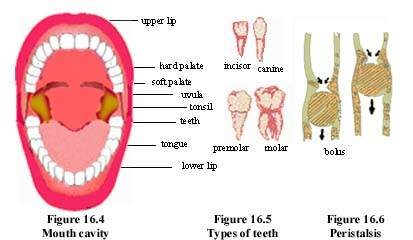In higher organisms the organs of digestion include
the alimentary canal and digestive glands. The alimentary
canal serves as a passage for food while the digestive glands secrete
the enzymes which help in the process of digestion. As the
complex food passes through the alimentary canal the following things
occur:
(i) Carbohydrates are broken down and converted
into glucose.
(ii) Proteins are converted into amino acids,
and
(iii) Fats are converted into fatty acids and
glycerol.
Human Digestive System
The human digestive system consists of the two
parts :
(1) Alimentary canal and (2) Associated glands.
(1) Alimentary canal
It is a muscular and glandular tube in which food
is passed forward by peristalsis. It is a sort of fuel
refinery. Food provides crude fuel to this refinery while the
glands supply fluids and enzymes to break down the fuel. The system
often works steadily and automatically, except sometimes under protest,
in the form of constipation, diarrhea, ulcers etc.
-
Mouth and mouth cavity : The mouth is
the anterior opening guarded by a pair of fleshy lips, leading
into mouth cavity bounded by the upper and lower jaws bearing
32 teeth in an average adult. It is bound by cheeks on two sides,
the hard and soft palate as the roof and tongue on the
floor. The teeth are of four types, (i) incisors or cutting
teeth, (ii) canines which are the tearing teeth and (iii)
premolars and (iv) molars that are the grinding
teeth.

[next page]